warning HYUNDAI I10 2017 User Guide
[x] Cancel search | Manufacturer: HYUNDAI, Model Year: 2017, Model line: I10, Model: HYUNDAI I10 2017Pages: 343, PDF Size: 9.14 MB
Page 25 of 343
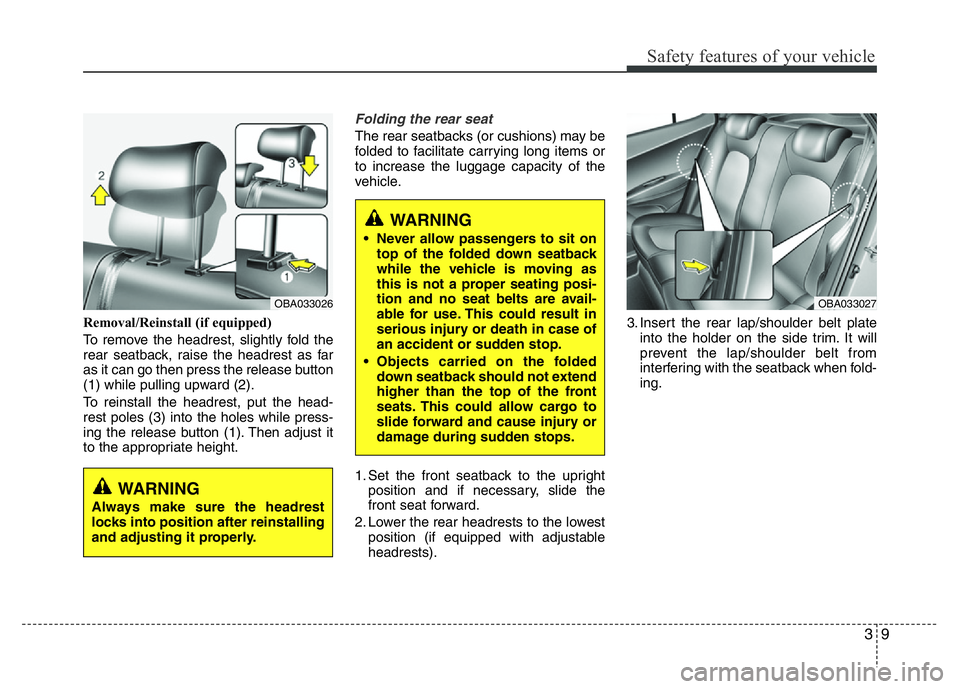
39
Safety features of your vehicle
Removal/Reinstall (if equipped)
To remove the headrest, slightly fold the
rear seatback, raise the headrest as far
as it can go then press the release button
(1) while pulling upward (2).
To reinstall the headrest, put the head-
rest poles (3) into the holes while press-
ing the release button (1). Then adjust it
to the appropriate height.
Folding the rear seat
The rear seatbacks (or cushions) may be
folded to facilitate carrying long items or
to increase the luggage capacity of the
vehicle.
1. Set the front seatback to the upright
position and if necessary, slide the
front seat forward.
2. Lower the rear headrests to the lowest
position (if equipped with adjustable
headrests).3. Insert the rear lap/shoulder belt plate
into the holder on the side trim. It will
prevent the lap/shoulder belt from
interfering with the seatback when fold-
ing.
WARNING
• Never allow passengers to sit on
top of the folded down seatback
while the vehicle is moving as
this is not a proper seating posi-
tion and no seat belts are avail-
able for use. This could result in
serious injury or death in case of
an accident or sudden stop.
• Objects carried on the folded
down seatback should not extend
higher than the top of the front
seats. This could allow cargo to
slide forward and cause injury or
damage during sudden stops.
OBA033026OBA033027
WARNING
Always make sure the headrest
locks into position after reinstalling
and adjusting it properly.
Page 26 of 343
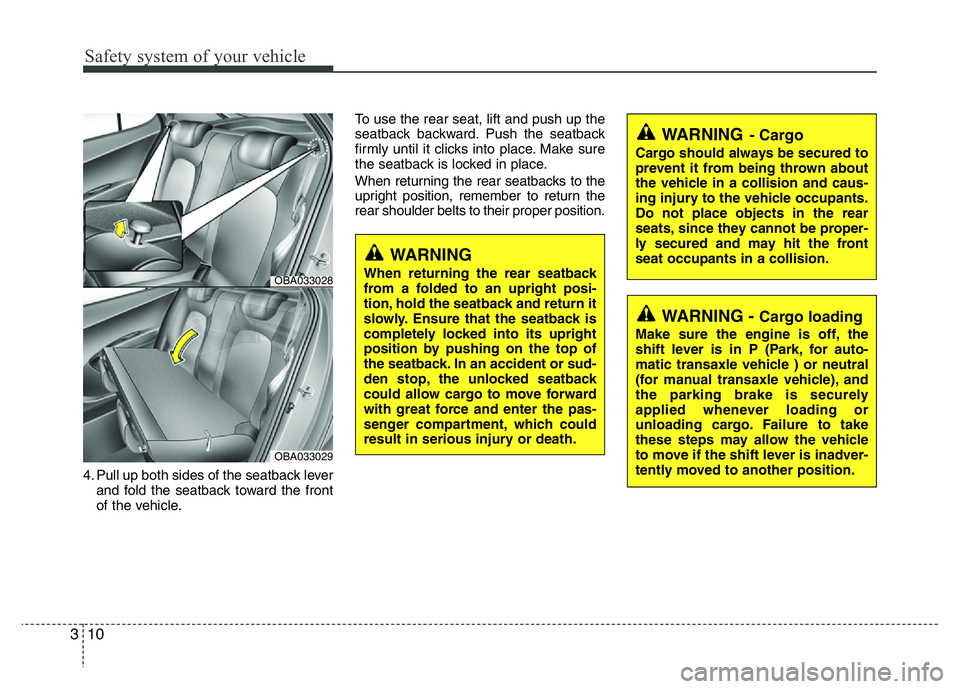
Safety system of your vehicle
10 3
4. Pull up both sides of the seatback lever
and fold the seatback toward the front
of the vehicle.To use the rear seat, lift and push up the
seatback backward. Push the seatback
firmly until it clicks into place. Make sure
the seatback is locked in place.
When returning the rear seatbacks to the
upright position, remember to return the
rear shoulder belts to their proper position.
WARNING
When returning the rear seatback
from a folded to an upright posi-
tion, hold the seatback and return it
slowly. Ensure that the seatback is
completely locked into its upright
position by pushing on the top of
the seatback. In an accident or sud-
den stop, the unlocked seatback
could allow cargo to move forward
with great force and enter the pas-
senger compartment, which could
result in serious injury or death.
WARNING- Cargo
Cargo should always be secured to
prevent it from being thrown about
the vehicle in a collision and caus-
ing injury to the vehicle occupants.
Do not place objects in the rear
seats, since they cannot be proper-
ly secured and may hit the front
seat occupants in a collision.
WARNING - Cargo loading
Make sure the engine is off, the
shift lever is in P (Park, for auto-
matic transaxle vehicle ) or neutral
(for manual transaxle vehicle), and
the parking brake is securely
applied whenever loading or
unloading cargo. Failure to take
these steps may allow the vehicle
to move if the shift lever is inadver-
tently moved to another position.
OBA033028
OBA033029
Page 27 of 343
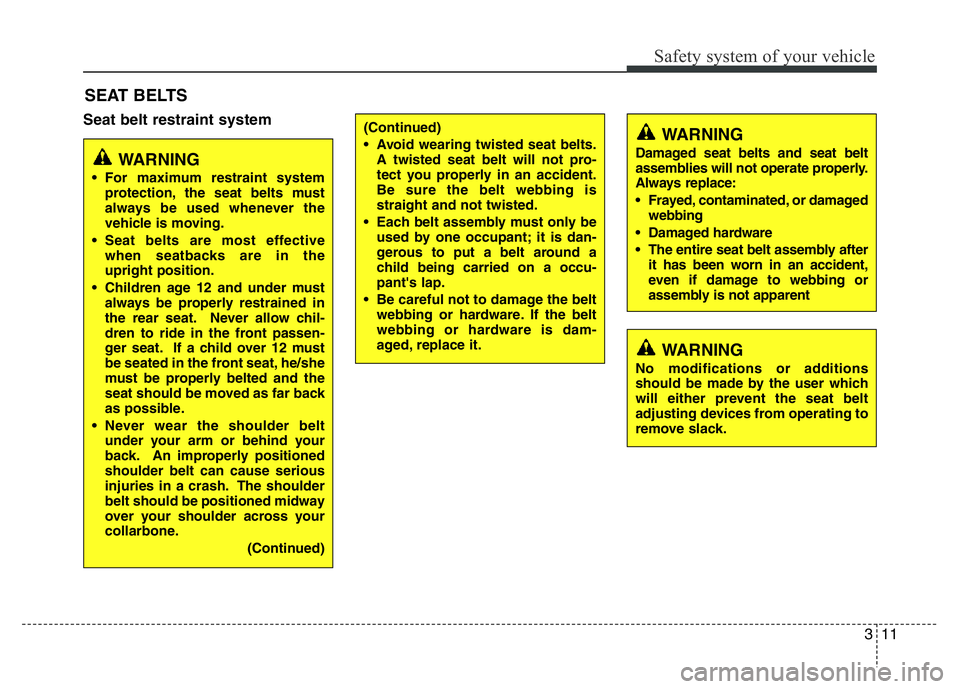
311
Safety system of your vehicle
Seat belt restraint system
SEAT BELTS
(Continued)
• Avoid wearing twisted seat belts.
A twisted seat belt will not pro-
tect you properly in an accident.
Be sure the belt webbing is
straight and not twisted.
• Each belt assembly must only be
used by one occupant; it is dan-
gerous to put a belt around a
child being carried on a occu-
pant's lap.
• Be careful not to damage the belt
webbing or hardware. If the belt
webbing or hardware is dam-
aged, replace it.WARNING
Damaged seat belts and seat belt
assemblies will not operate properly.
Always replace:
• Frayed, contaminated, or damaged
webbing
• Damaged hardware
• The entire seat belt assembly after
it has been worn in an accident,
even if damage to webbing or
assembly is not apparent
WARNING
No modifications or additions
should be made by the user which
will either prevent the seat belt
adjusting devices from operating to
remove slack.
WARNING
• For maximum restraint system
protection, the seat belts must
always be used whenever the
vehicle is moving.
• Seat belts are most effective
when seatbacks are in the
upright position.
• Children age 12 and under must
always be properly restrained in
the rear seat. Never allow chil-
dren to ride in the front passen-
ger seat. If a child over 12 must
be seated in the front seat, he/she
must be properly belted and the
seat should be moved as far back
as possible.
• Never wear the shoulder belt
under your arm or behind your
back. An improperly positioned
shoulder belt can cause serious
injuries in a crash. The shoulder
belt should be positioned midway
over your shoulder across your
collarbone.
(Continued)
Page 28 of 343
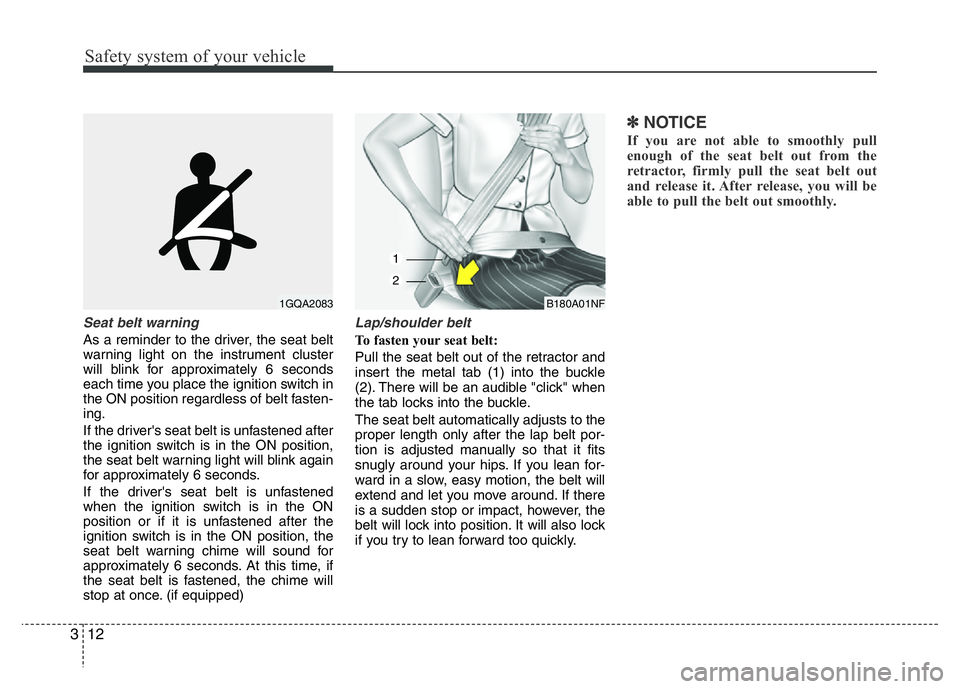
Safety system of your vehicle
12 3
Seat belt warning
As a reminder to the driver, the seat belt
warning light on the instrument cluster
will blink for approximately 6 seconds
each time you place the ignition switch in
the ON position regardless of belt fasten-
ing.
If the driver's seat belt is unfastened after
the ignition switch is in the ON position,
the seat belt warning light will blink again
for approximately 6 seconds.
If the driver's seat belt is unfastened
when the ignition switch is in the ON
position or if it is unfastened after the
ignition switch is in the ON position, the
seat belt warning chime will sound for
approximately 6 seconds. At this time, if
the seat belt is fastened, the chime will
stop at once. (if equipped)
Lap/shoulder belt
To fasten your seat belt:
Pull the seat belt out of the retractor and
insert the metal tab (1) into the buckle
(2). There will be an audible "click" when
the tab locks into the buckle.
The seat belt automatically adjusts to the
proper length only after the lap belt por-
tion is adjusted manually so that it fits
snugly around your hips. If you lean for-
ward in a slow, easy motion, the belt will
extend and let you move around. If there
is a sudden stop or impact, however, the
belt will lock into position. It will also lock
if you try to lean forward too quickly.
✽NOTICE
If you are not able to smoothly pull
enough of the seat belt out from the
retractor, firmly pull the seat belt out
and release it. After release, you will be
able to pull the belt out smoothly.
1GQA2083B180A01NF
1
2
Page 29 of 343
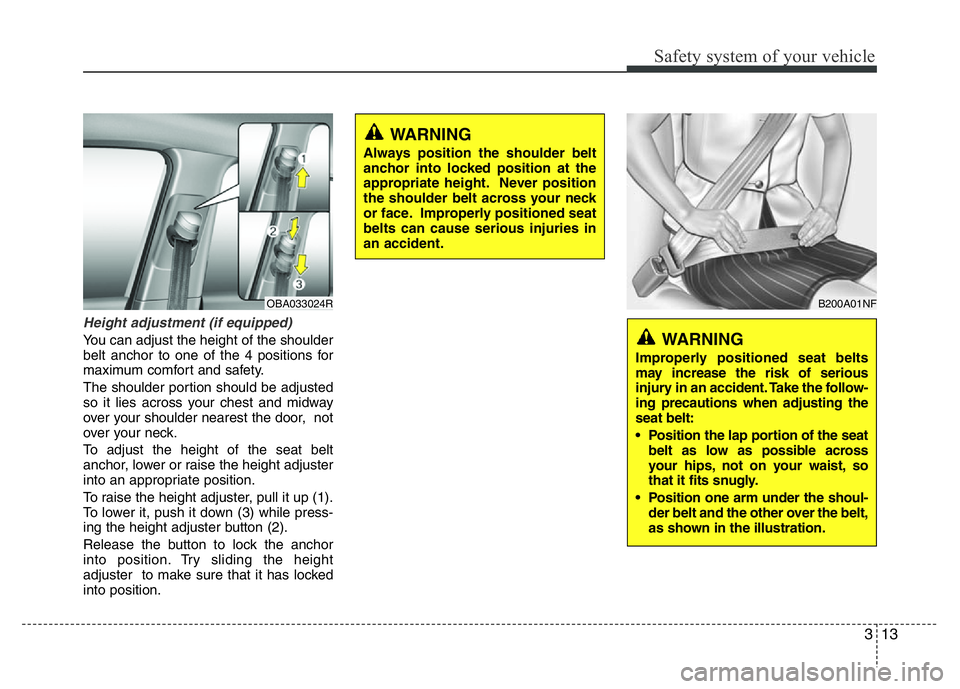
313
Safety system of your vehicle
Height adjustment (if equipped)
You can adjust the height of the shoulder
belt anchor to one of the 4 positions for
maximum comfort and safety.
The shoulder portion should be adjusted
so it lies across your chest and midway
over your shoulder nearest the door, not
over your neck.
To adjust the height of the seat belt
anchor, lower or raise the height adjuster
into an appropriate position.
To raise the height adjuster, pull it up (1).
To lower it, push it down (3) while press-
ing the height adjuster button (2).
Release the button to lock the anchor
into position. Try sliding the height
adjuster to make sure that it has locked
into position.
WARNING
Always position the shoulder belt
anchor into locked position at the
appropriate height. Never position
the shoulder belt across your neck
or face. Improperly positioned seat
belts can cause serious injuries in
an accident.
B200A01NF
WARNING
Improperly positioned seat belts
may increase the risk of serious
injury in an accident. Take the follow-
ing precautions when adjusting the
seat belt:
• Position the lap portion of the seat
belt as low as possible across
your hips, not on your waist, so
that it fits snugly.
• Position one arm under the shoul-
der belt and the other over the belt,
as shown in the illustration.
OBA033024R
Page 32 of 343
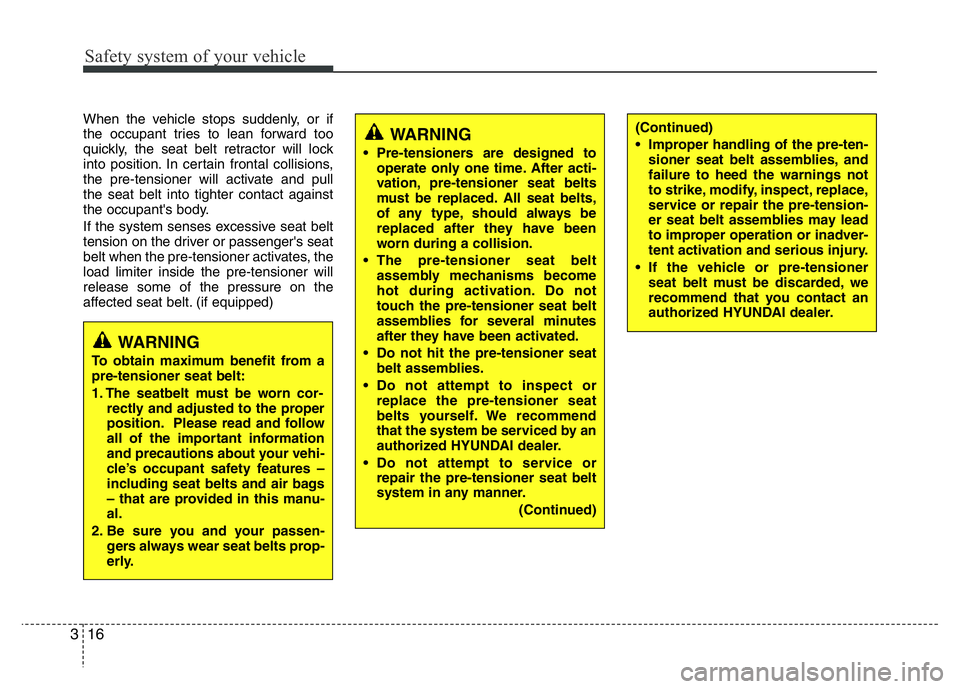
Safety system of your vehicle
16 3
When the vehicle stops suddenly, or if
the occupant tries to lean forward too
quickly, the seat belt retractor will lock
into position. In certain frontal collisions,
the pre-tensioner will activate and pull
the seat belt into tighter contact against
the occupant's body.
If the system senses excessive seat belt
tension on the driver or passenger's seat
belt when the pre-tensioner activates, the
load limiter inside the pre-tensioner will
release some of the pressure on the
affected seat belt. (if equipped)(Continued)
• Improper handling of the pre-ten-
sioner seat belt assemblies, and
failure to heed the warnings not
to strike, modify, inspect, replace,
service or repair the pre-tension-
er seat belt assemblies may lead
to improper operation or inadver-
tent activation and serious injury.
• If the vehicle or pre-tensioner
seat belt must be discarded, we
recommend that you contact an
authorized HYUNDAI dealer.WARNING
• Pre-tensioners are designed to
operate only one time. After acti-
vation, pre-tensioner seat belts
must be replaced. All seat belts,
of any type, should always be
replaced after they have been
worn during a collision.
• The pre-tensioner seat belt
assembly mechanisms become
hot during activation. Do not
touch the pre-tensioner seat belt
assemblies for several minutes
after they have been activated.
• Do not hit the pre-tensioner seat
belt assemblies.
• Do not attempt to inspect or
replace the pre-tensioner seat
belts yourself. We recommend
that the system be serviced by an
authorized HYUNDAI dealer.
• Do not attempt to service or
repair the pre-tensioner seat belt
system in any manner.
(Continued)
WARNING
To obtain maximum benefit from a
pre-tensioner seat belt:
1. The seatbelt must be worn cor-
rectly and adjusted to the proper
position. Please read and follow
all of the important information
and precautions about your vehi-
cle’s occupant safety features –
including seat belts and air bags
– that are provided in this manu-
al.
2. Be sure you and your passen-
gers always wear seat belts prop-
erly.
Page 33 of 343
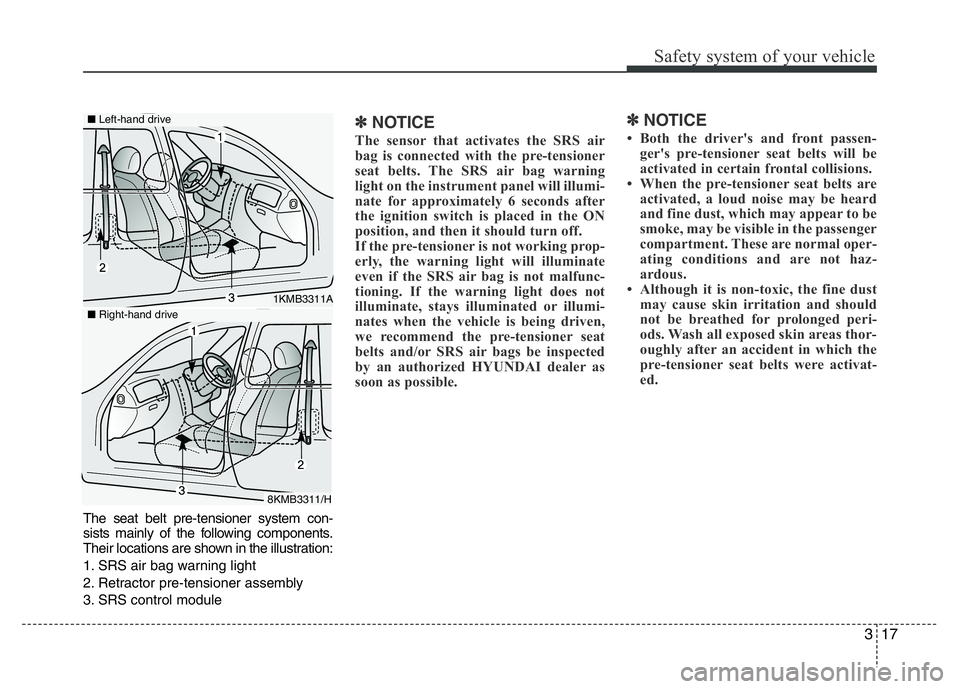
317
Safety system of your vehicle
The seat belt pre-tensioner system con-
sists mainly of the following components.
Their locations are shown in the illustration:
1. SRS air bag warning light
2. Retractor pre-tensioner assembly
3. SRS control module
✽NOTICE
The sensor that activates the SRS air
bag is connected with the pre-tensioner
seat belts. The SRS air bag warning
light on the instrument panel will illumi-
nate for approximately 6 seconds after
the ignition switch is placed in the ON
position, and then it should turn off.
If the pre-tensioner is not working prop-
erly, the warning light will illuminate
even if the SRS air bag is not malfunc-
tioning. If the warning light does not
illuminate, stays illuminated or illumi-
nates when the vehicle is being driven,
we recommend the pre-tensioner seat
belts and/or SRS air bags be inspected
by an authorized HYUNDAI dealer as
soon as possible.
✽NOTICE
• Both the driver's and front passen-
ger's pre-tensioner seat belts will be
activated in certain frontal collisions.
• When the pre-tensioner seat belts are
activated, a loud noise may be heard
and fine dust, which may appear to be
smoke, may be visible in the passenger
compartment. These are normal oper-
ating conditions and are not haz-
ardous.
• Although it is non-toxic, the fine dust
may cause skin irritation and should
not be breathed for prolonged peri-
ods. Wash all exposed skin areas thor-
oughly after an accident in which the
pre-tensioner seat belts were activat-
ed.
1KMB3311A
■Left-hand drive
8KMB3311/H
■Right-hand drive
Page 34 of 343
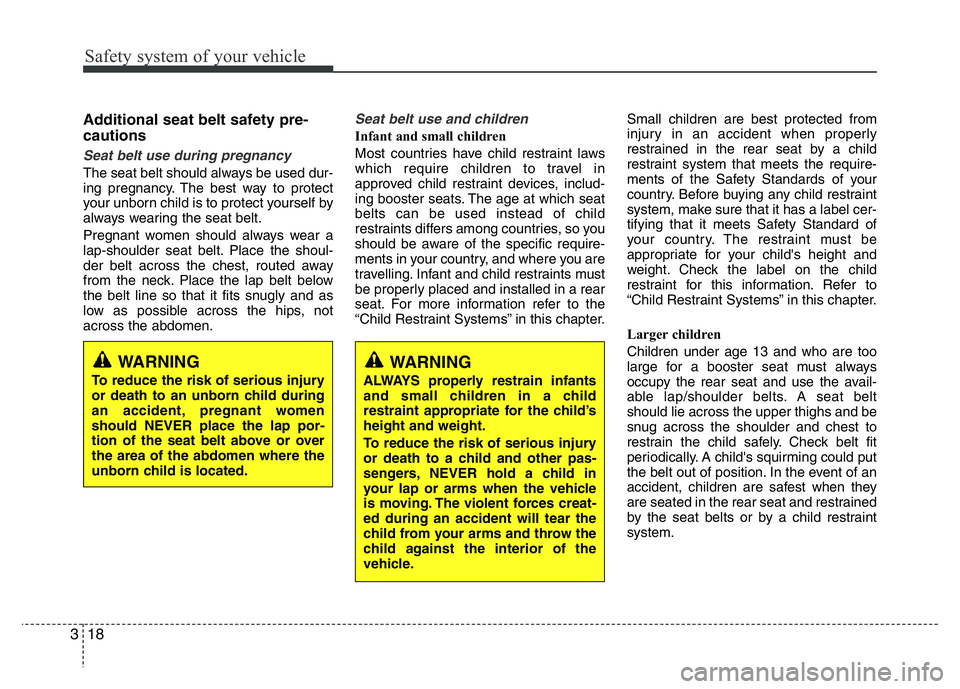
Safety system of your vehicle
18 3
Additional seat belt safety pre-
cautions
Seat belt use during pregnancy
The seat belt should always be used dur-
ing pregnancy. The best way to protect
your unborn child is to protect yourself by
always wearing the seat belt.
Pregnant women should always wear a
lap-shoulder seat belt. Place the shoul-
der belt across the chest, routed away
from the neck. Place the lap belt below
the belt line so that it fits snugly and as
low as possible across the hips, not
across the abdomen.
Seat belt use and children
Infant and small children
Most countries have child restraint laws
which require children to travel in
approved child restraint devices, includ-
ing booster seats. The age at which seat
belts can be used instead of child
restraints differs among countries, so you
should be aware of the specific require-
ments in your country, and where you are
travelling. Infant and child restraints must
be properly placed and installed in a rear
seat. For more information refer to the
“Child Restraint Systems” in this chapter.Small children are best protected from
injury in an accident when properly
restrained in the rear seat by a child
restraint system that meets the require-
ments of the Safety Standards of your
country. Before buying any child restraint
system, make sure that it has a label cer-
tifying that it meets Safety Standard of
your country. The restraint must be
appropriate for your child's height and
weight. Check the label on the child
restraint for this information. Refer to
“Child Restraint Systems” in this chapter.
Larger children
Children under age 13 and who are too
large for a booster seat must always
occupy the rear seat and use the avail-
able lap/shoulder belts. A seat belt
should lie across the upper thighs and be
snug across the shoulder and chest to
restrain the child safely. Check belt fit
periodically. A child's squirming could put
the belt out of position. In the event of an
accident, children are safest when they
are seated in the rear seat and restrained
by the seat belts or by a child restraint
system.
WARNING
To reduce the risk of serious injury
or death to an unborn child during
an accident, pregnant women
should NEVER place the lap por-
tion of the seat belt above or over
the area of the abdomen where the
unborn child is located.
WARNING
ALWAYS properly restrain infants
and small children in a child
restraint appropriate for the child’s
height and weight.
To reduce the risk of serious injury
or death to a child and other pas-
sengers, NEVER hold a child in
your lap or arms when the vehicle
is moving. The violent forces creat-
ed during an accident will tear the
child from your arms and throw the
child against the interior of the
vehicle.
Page 35 of 343
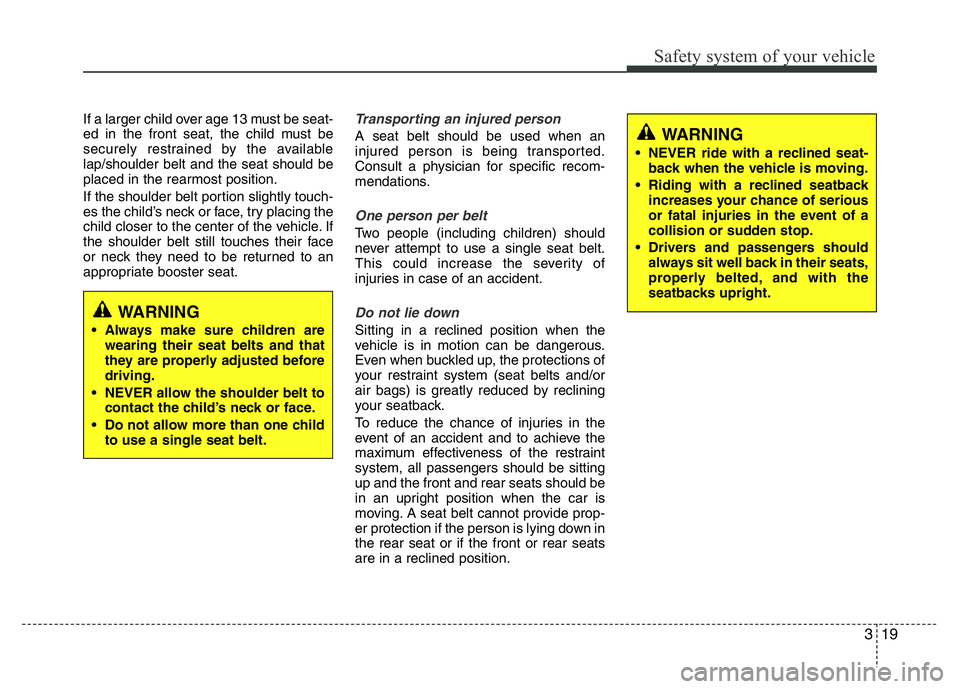
319
Safety system of your vehicle
If a larger child over age 13 must be seat-
ed in the front seat, the child must be
securely restrained by the available
lap/shoulder belt and the seat should be
placed in the rearmost position.
If the shoulder belt portion slightly touch-
es the child’s neck or face, try placing the
child closer to the center of the vehicle. If
the shoulder belt still touches their face
or neck they need to be returned to an
appropriate booster seat.Transporting an injured person
A seat belt should be used when an
injured person is being transported.
Consult a physician for specific recom-
mendations.
One person per belt
Two people (including children) should
never attempt to use a single seat belt.
This could increase the severity of
injuries in case of an accident.
Do not lie down
Sitting in a reclined position when the
vehicle is in motion can be dangerous.
Even when buckled up, the protections of
your restraint system (seat belts and/or
air bags) is greatly reduced by reclining
your seatback.
To reduce the chance of injuries in the
event of an accident and to achieve the
maximum effectiveness of the restraint
system, all passengers should be sitting
up and the front and rear seats should be
in an upright position when the car is
moving. A seat belt cannot provide prop-
er protection if the person is lying down in
the rear seat or if the front or rear seats
are in a reclined position.
WARNING
• Always make sure children are
wearing their seat belts and that
they are properly adjusted before
driving.
• NEVER allow the shoulder belt to
contact the child’s neck or face.
• Do not allow more than one child
to use a single seat belt.
WARNING
• NEVER ride with a reclined seat-
back when the vehicle is moving.
• Riding with a reclined seatback
increases your chance of serious
or fatal injuries in the event of a
collision or sudden stop.
• Drivers and passengers should
always sit well back in their seats,
properly belted, and with the
seatbacks upright.
Page 37 of 343
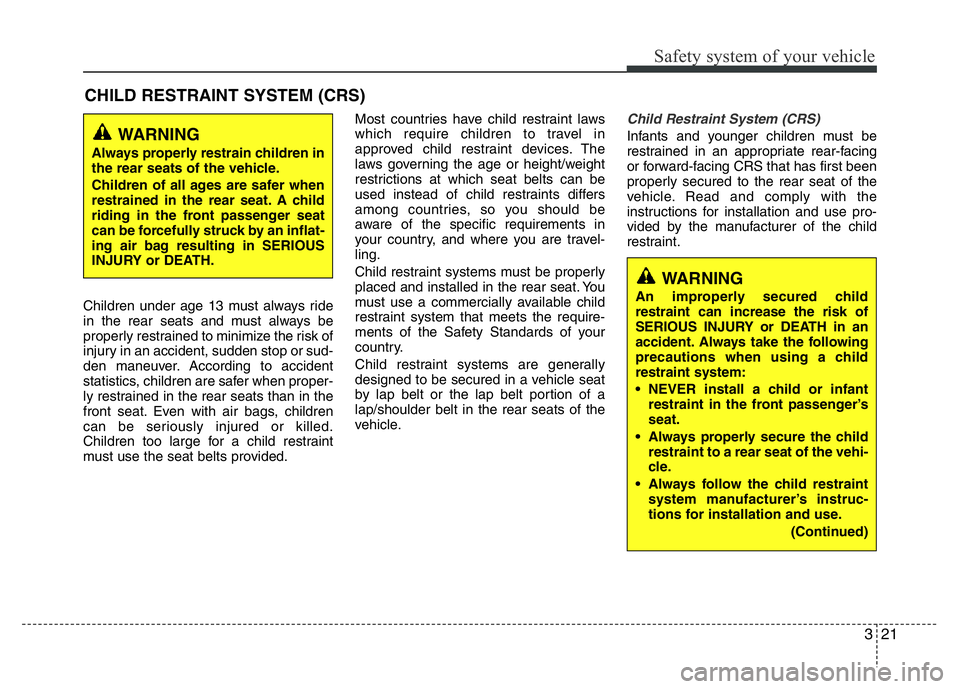
321
Safety system of your vehicle
CHILD RESTRAINT SYSTEM (CRS)
Children under age 13 must always ride
in the rear seats and must always be
properly restrained to minimize the risk of
injury in an accident, sudden stop or sud-
den maneuver. According to accident
statistics, children are safer when proper-
ly restrained in the rear seats than in the
front seat. Even with air bags, children
can be seriously injured or killed.
Children too large for a child restraint
must use the seat belts provided.Most countries have child restraint laws
which require children to travel in
approved child restraint devices. The
laws governing the age or height/weight
restrictions at which seat belts can be
used instead of child restraints differs
among countries, so you should be
aware of the specific requirements in
your country, and where you are travel-
ling.
Child restraint systems must be properly
placed and installed in the rear seat. You
must use a commercially available child
restraint system that meets the require-
ments of the Safety Standards of your
country.
Child restraint systems are generally
designed to be secured in a vehicle seat
by lap belt or the lap belt portion of a
lap/shoulder belt in the rear seats of the
vehicle.
Child Restraint System (CRS)
Infants and younger children must be
restrained in an appropriate rear-facing
or forward-facing CRS that has first been
properly secured to the rear seat of the
vehicle. Read and comply with the
instructions for installation and use pro-
vided by the manufacturer of the child
restraint.WARNING
Always properly restrain children in
the rear seats of the vehicle.
Children of all ages are safer when
restrained in the rear seat. A child
riding in the front passenger seat
can be forcefully struck by an inflat-
ing air bag resulting in SERIOUS
INJURY or DEATH.
WARNING
An improperly secured child
restraint can increase the risk of
SERIOUS INJURY or DEATH in an
accident. Always take the following
precautions when using a child
restraint system:
• NEVER install a child or infant
restraint in the front passenger’s
seat.
• Always properly secure the child
restraint to a rear seat of the vehi-
cle.
• Always follow the child restraint
system manufacturer’s instruc-
tions for installation and use.
(Continued)